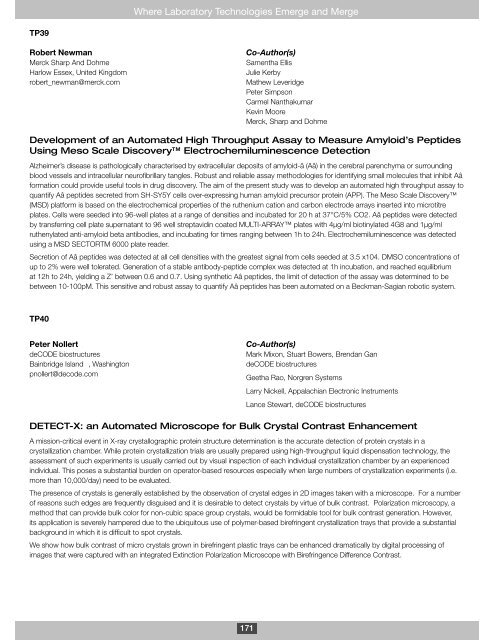LabAutomation 2006 - SLAS
LabAutomation 2006 - SLAS
LabAutomation 2006 - SLAS
You also want an ePaper? Increase the reach of your titles
YUMPU automatically turns print PDFs into web optimized ePapers that Google loves.
TP39<br />
Robert Newman<br />
Merck Sharp And Dohme<br />
Harlow Essex, United Kingdom<br />
robert_newman@merck.com<br />
Where Laboratory Technologies Emerge and Merge<br />
Co-Author(s)<br />
Samentha Ellis<br />
Julie Kerby<br />
Mathew Leveridge<br />
Peter Simpson<br />
Carmel Nanthakumar<br />
Kevin Moore<br />
Merck, Sharp and Dohme<br />
Development of an Automated High Throughput Assay to Measure Amyloid’s Peptides<br />
Using Meso Scale Discovery Electrochemiluminescence Detection<br />
Alzheimer’s disease is pathologically characterised by extracellular deposits of amyloid-â (Aâ) in the cerebral parenchyma or surrounding<br />
blood vessels and intracellular neurofibrillary tangles. Robust and reliable assay methodologies for identifying small molecules that inhibit Aâ<br />
formation could provide useful tools in drug discovery. The aim of the present study was to develop an automated high throughput assay to<br />
quantify Aâ peptides secreted from SH-SY5Y cells over-expressing human amyloid precursor protein (APP). The Meso Scale Discovery<br />
(MSD) platform is based on the electrochemical properties of the ruthenium cation and carbon electrode arrays inserted into microtitre<br />
plates. Cells were seeded into 96-well plates at a range of densities and incubated for 20 h at 37°C/5% CO2. Aâ peptides were detected<br />
by transferring cell plate supernatant to 96 well streptavidin coated MULTI-ARRAY plates with 4µg/ml biotinylated 4G8 and 1µg/ml<br />
ruthenylated anti-amyloid beta antibodies, and incubating for times ranging between 1h to 24h. Electrochemiluminescence was detected<br />
using a MSD SECTORTM 6000 plate reader.<br />
Secretion of Aâ peptides was detected at all cell densities with the greatest signal from cells seeded at 3.5 x104. DMSO concentrations of<br />
up to 2% were well tolerated. Generation of a stable antibody-peptide complex was detected at 1h incubation, and reached equilibrium<br />
at 12h to 24h, yielding a Z’ between 0.6 and 0.7. Using synthetic Aâ peptides, the limit of detection of the assay was determined to be<br />
between 10-100pM. This sensitive and robust assay to quantify Aâ peptides has been automated on a Beckman-Sagian robotic system.<br />
TP40<br />
Peter Nollert<br />
deCODE biostructures<br />
Bainbridge Island , Washington<br />
pnollert@decode.com<br />
Co-Author(s)<br />
Mark Mixon, Stuart Bowers, Brendan Gan<br />
deCODE biostructures<br />
Geetha Rao, Norgren Systems<br />
Larry Nickell, Appalachian Electronic Instruments<br />
Lance Stewart, deCODE biostructures<br />
DETECT-X: an Automated Microscope for Bulk Crystal Contrast Enhancement<br />
A mission-critical event in X-ray crystallographic protein structure determination is the accurate detection of protein crystals in a<br />
crystallization chamber. While protein crystallization trials are usually prepared using high-throughput liquid dispensation technology, the<br />
assessment of such experiments is usually carried out by visual inspection of each individual crystallization chamber by an experienced<br />
individual. This poses a substantial burden on operator-based resources especially when large numbers of crystallization experiments (i.e.<br />
more than 10,000/day) need to be evaluated.<br />
The presence of crystals is generally established by the observation of crystal edges in 2D images taken with a microscope. For a number<br />
of reasons such edges are frequently disguised and it is desirable to detect crystals by virtue of bulk contrast. Polarization microscopy, a<br />
method that can provide bulk color for non-cubic space group crystals, would be formidable tool for bulk contrast generation. However,<br />
its application is severely hampered due to the ubiquitous use of polymer-based birefringent crystallization trays that provide a substantial<br />
background in which it is difficult to spot crystals.<br />
We show how bulk contrast of micro crystals grown in birefringent plastic trays can be enhanced dramatically by digital processing of<br />
images that were captured with an integrated Extinction Polarization Microscope with Birefringence Difference Contrast.<br />
171
















